
In 2016, a small fishing village on the west coast of Kenya broke new ground: Gazi’s Mikoko Pamoja project became the first-ever mangrove conservation project linked to global carbon markets. The community-led restoration initiative began selling carbon credits to fund the planting and conservation of the local mangrove forest, while providing a steady source of income for the community. The money has allowed the villagers to expand freshwater access by installing plumbing or wells and improve schooling by renovating classrooms and buying textbooks.
Seven years on, Mikoko Pamoja is heralded as a template for how the world can use the power of marine-based ecosystems in its fight against climate change. The Intergovernmental Panel on Climate Change (IPCC) has made it clear that to reach net-zero emissions by 2050, we will not only need to rapidly slash greenhouse gas emissions across the global economy but also remove vast quantities of carbon dioxide (CO₂) from the atmosphere – roughly ten gigatonnes of the stuff a year by 2050.
So far, carbon removal technologies have focused on land-based approaches: growing trees, building large fans to suck CO₂ from the air, speeding up rock weathering. However, a growing cadre of scientists, companies and governments are turning to the ocean for potential carbon removal solutions.
These new approaches aim to utilise the ocean’s natural chemical and biological processes to absorb and store carbon from the atmosphere. This is the frontier of carbon removal: these “blue carbon” approaches offer the potential to be gamechangers for the climate action agenda, but there is still little known about the true extent of carbon-sequestering potential or the side effects that pursuing them at scale could have on the environment and local communities.
“Worldwide, blue carbon ecosystems are estimated to store six to 12 gigatonnes of carbon in their biomass and soils on a per hectare basis,” said Lisa Schindler Murray, director of natural climate solutions and blue carbon at US conservation group Rare, during a recent webinar hosted by global research nonprofit the World Resources Institute (WRI). “Given this potential scale, it is certainly one of the critical tools to support climate action, but it is not a silver bullet; like any other nature-based solution, it needs to be paired with other emission-reduction measures in order to achieve the goals of the Paris Agreement.”
Sinking carbon
Blue carbon is the shorthand for carbon that is captured and stored from the atmosphere by marine and coastal ecosystems such as mangrove forests, seagrass meadows and tidal marshes. These ecosystems are thought to be able to store five times more carbon per hectare than tropical forests and absorb it from the atmosphere three times faster. Despite only covering 0.5% of the seafloor, blue carbon ecosystems could account for 50% of all marine-based carbon.

US Tariffs are shifting - will you react or anticipate?
Don’t let policy changes catch you off guard. Stay proactive with real-time data and expert analysis.
By GlobalDataIn fact, a study published in Nature in May found that the alkalinity enhancement driven by the restoration of just mangrove and seagrass systems could permanently capture up to 1% of total fossil fuel CO₂ emissions.
One of the reasons for the incredible efficiency of this carbon sequestration is that plants contained in these ecosystems grow extremely rapidly. They also typically thrive in oxygen-deprived, or “anaerobic”, soils. This helps slow the plant decomposition that releases carbon back into the atmosphere, meaning the carbon can be stored for lengthy periods, often hundreds of thousands of years.
Plants in blue carbon ecosystems are also adapted to live on the intersections of land and sea. As such, they can survive salinity and temperature changes, and their root systems allow them to withstand tidal flows and storm surges.
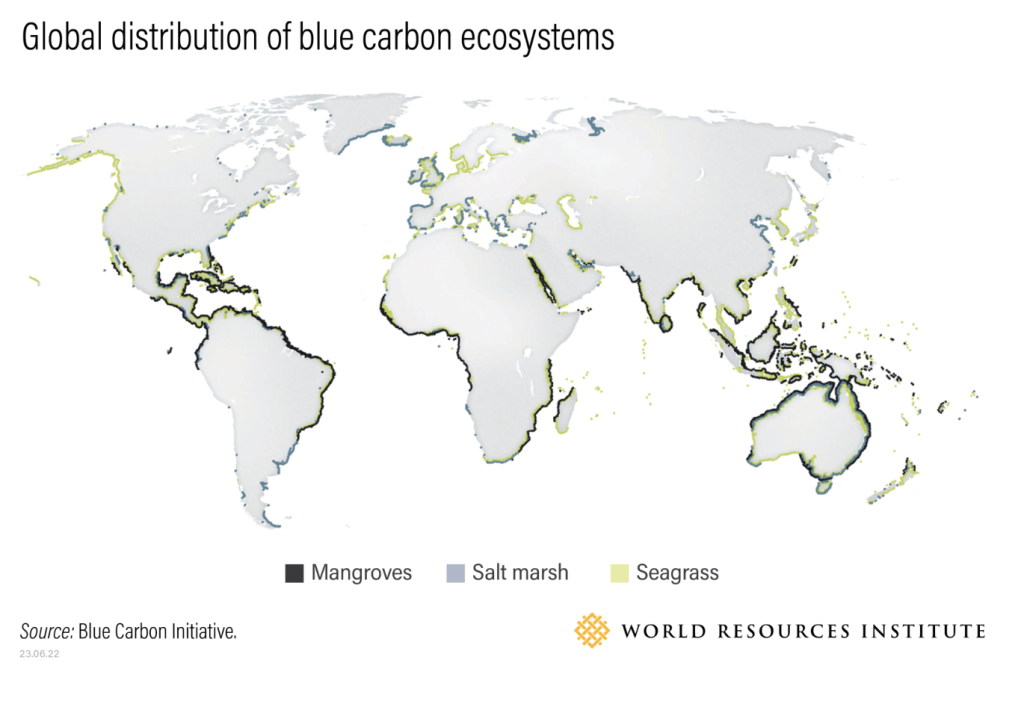
The ocean is an effective carbon sink as it has already absorbed 30% of the CO₂ – and 90% of the excess heat – caused by human activities, allaying some of the worst impacts of climate change. The ocean holds around 42-times more carbon than the atmosphere.
This has not come without its costs, however. The excess CO₂ and heat are driving ocean warming, acidification and oxygen loss; altering currents and nutrient cycles; and endangering plants and animals reliant on these ecosystems. These changes are imperiling the ocean’s ability to provide food, livelihoods and protection from the worst effects of climate change.
“It is estimated that globally 50% of salt marshes, 35% of mangroves and 29% of seagrasses have been degraded or lost since the mid-20th century,” said Schindler Murray.
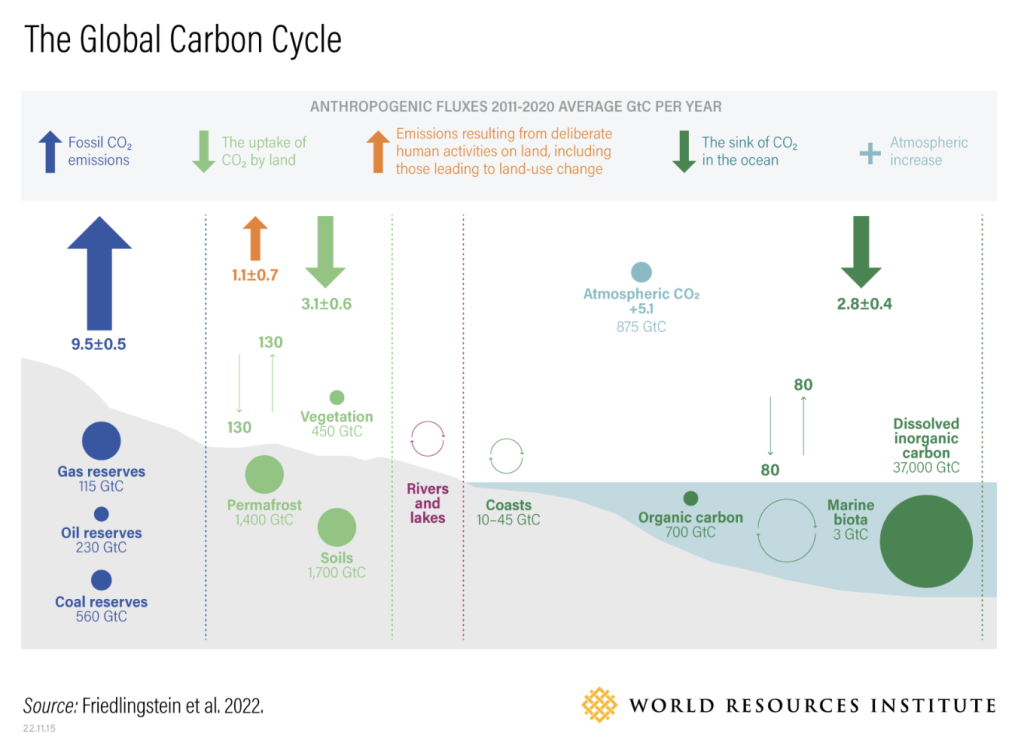
However, many experts believe that, despite their carbon sequestering abilities, blue carbon ecosystems’ primary strengths lie elsewhere. They provide a wide array of so-called “co-benefits” to people and nature, such as bolstering fisheries, enhancing biodiversity and protecting coastal protection from extreme weather events. “The co-benefits of mangroves are much, much wider than the tradable carbon,” said James Kairo, chief scientist of the Kenya Marine and Fisheries Research Institute, on the WRI webinar. Kairo had been one of the leads on the Mikoko Pamoja project.
For instance, another study published in Nature in June found that protecting the remaining 64,000 hectares (ha) of healthy mangroves across Belize would preserve up to 41.1 million metric tonnes (mmt) of organic carbon stock and 150.6mmt of carbon dioxide equivalents (CO₂e). Importantly, this would also safeguard 800,000lbs of spiny lobster catch worth Bz$6m ($2.98m) annually, foster continued visits of at least 4,000 tourists to mangrove destinations annually (generating Bz$600,000 in expenditures) and nearly halve the number of people otherwise at the highest risk from coastal hazards in 2030 without risk reduction provided by mangroves.
Keep up with Energy Monitor: Subscribe to our weekly newsletterSimilarly, restoring 13,000ha of mangroves would increase total organic carbon stock by 1.67mmt of organic carbon stock (6.12mmt of CO₂e), augment lobster catch by 700,000lbs annually, draw an additional 20,000 visitors annually (generating nearly Bz$3m) and further reduce risk from coastal hazards.
Blue carbon: biotic vs abiotic
There is a wide range of ocean-based, or blue carbon, removal approaches, some already widely deployed and others existing solely on paper. Coastal wetland restoration, for instance, has been practised for decades but primarily to support resilience and ecosystem benefits rather than to sequester carbon.
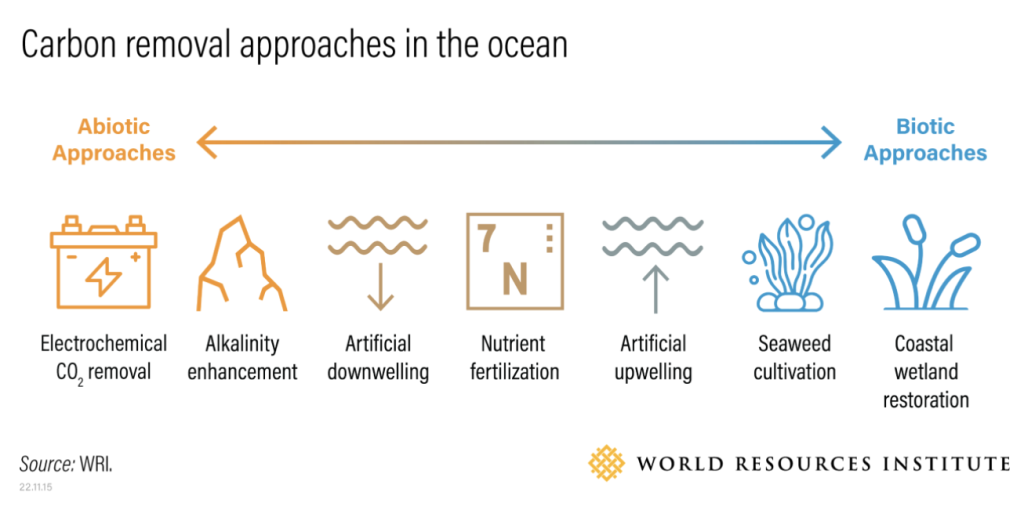
“Abiotic” approaches leverage the physical or chemical properties of blue carbon ecosystems to sequester CO₂ from the air. Alkalinity enhancement, for example, involves adding chemicals to seawater to enable more CO₂ to dissolve into the ocean. This can also offer the added benefit of reducing ocean acidity. Electrochemical techniques, by contrast, use electricity to mimic alkalinity enhancement, or directly extract CO₂ from seawater to be stored on land. Artificial downwelling speeds up natural currents that pull carbon-rich surface water into the depths of the Arctic and Antarctic oceans.
“Biotic” approaches, on the other hand, use photosynthesising organisms in the ocean to absorb CO₂ and store the carbon in biomass. Seaweed, for example, can be farmed and then sunk to the seafloor, storing much of the carbon-rich biomass. Leveraging the sea’s biological pump, ocean fertilisation involves adding nutrients like iron to the ocean to encourage the growth of phytoplankton, which sucks up CO₂ and converts it into biomass, which then sinks to the bottom of the ocean. Conversely, artificial upwelling aims for the same result but does so by pushing nutrient-rich water from the depths to the surface, instead of adding new nutrients.
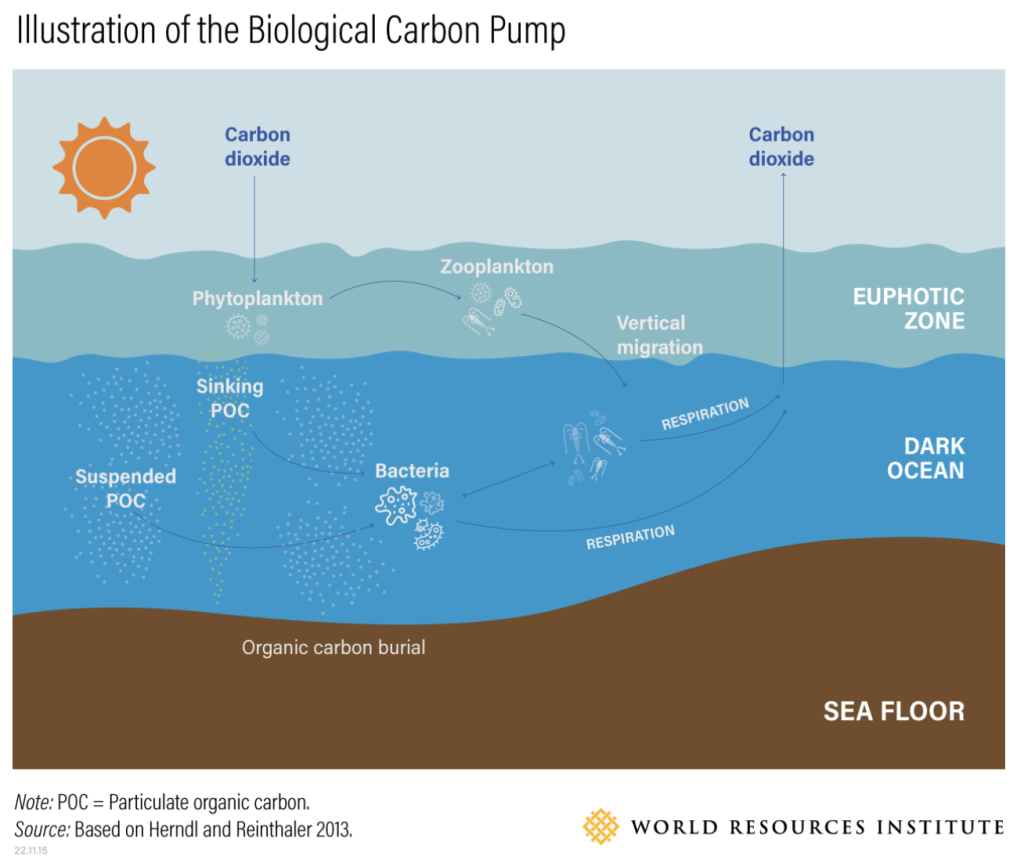
Countries such as the US and Japan specifically mention ocean-based carbon removal in their long-term climate action strategies submitted to the UN Framework Convention on Climate Change (UNFCCC). Carbon markets are facilitating investment in companies developing these approaches: Stripe and Shopify, for example, have invested in ocean carbon removal companies including Vesta, Running Tide and Planetary Technologies.
“We see carbon markets as an opportunity to bring investment into conservation and restorations of these ecosystems at scale; for both the carbon storage benefit and all the other values for communities and ecosystems,” said Emily Kelly, blue carbon lead at the World Economic Forum’s Ocean Action Agenda, on the WRI webinar. “Carbon markets can help assure suppliers of long-term demand to give them confidence in developing projects, and a key element here is also of course ensuring that there is demand for high-quality projects.”
Unchartered territory
However, most of these approaches are in their infancy, with little or no testing in the field. It is therefore not well understood how effective they will be at sequestering carbon at scale or in different locations, for how long that carbon will remain stored, and whether there will be any unintended consequences for the local environment.
It will be vitally important to explore both the potential and the risks of ocean-based carbon removal, looking beyond mere calculations of efficacy and cost, as well being highly selective as to which approaches to pursue.
Critics are rightly nervous about the negative consequences of the commercial arms race that is starting to unfurl in the blue carbon industry. Start-ups and investors are jostling for first-mover advantage and some researchers are worried that the science is getting lost among the sharp-elbowed gold rush for carbon credits.
Read more from this author: Oliver GordonFor example, several seaweed experts and marine biogeochemists have raised concerns that, if done at scale, seaweed carbon sequestration could in fact outcompete phytoplankton communities that already remove huge amounts of carbon and underpin marine food chains that support global fisheries, posing an existential threat to these life-supporting systems. Indeed, a perspective piece in Nature Ecology & Evolution in April last year warned that the field does not yet have sufficient scientific knowledge for companies to move ahead with these concepts.
“The question then is: do the advantages outweigh the risks?” asks Rudy Kahsar, manager of the carbon dioxide removal (CDR) team at the US-based think tank RMI. “There are always trade-offs; the big one here is local ecological damage vs climate change.
“But emissions continue to rise. The world is warming. We face major climate tipping points. Acidification of oceans is already destroying ocean ecosystems and endangering coral reefs. Climate change is altering land and marine ecosystems. Yes, there are risks to ocean CDR, but there are also risks to not doing anything.”
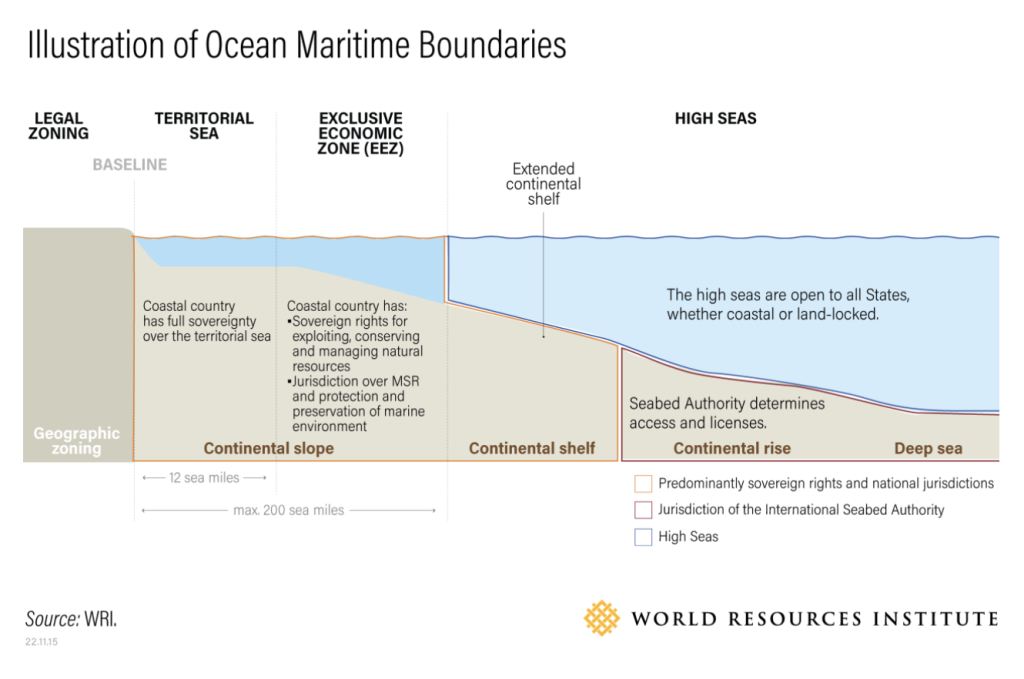
Proper regulation of the industry is thus paramount, but the logistics are problematic. Ocean CDR projects come into the jurisdiction of specific countries if they are located within 200 miles of their shores; everything else falls into the bracket of the “high seas” and is regulated by international frameworks pre-dating the existence of ocean CDR. These frameworks are typically geared towards averting polluting, dumping and the general harming of biodiversity – not to fill the scientific gaps of ocean CDR.
Even if projects do fall within national boundaries, fragmented governance systems will make it hard to tell whether research is being carried out responsibly, stop research if negative environmental or social impacts start to outweigh the benefits, or determine which regulators or stakeholders have the power to make these decisions.
“Ocean CDR is absolutely necessary to the world’s carbon removal portfolio, but we need to answer some critical research questions about impacts, develop robust policies and legal frameworks, and establish clear methodologies before we go charging into the space,” says Kahsar.
Blue carbon: proceed with caution
In order to scale the blue carbon industry to a sufficient size to make a meaningful contribution to the world’s carbon removal – and, by extension, net-zero – ambitions, the first step would be to establish a comprehensive governance framework that considers the full life cycle of ocean carbon removal research and projects, according to research from the WRI and the US’s National Academies. A code of conduct for research, and eventually commercial deployment, would be another important initial step, and could serve as the basis for a new international framework for sustainable and responsible ocean CDR. This will require an iterative and adaptive approach, and should be carried out under the joint auspices of the UNFCCC, Convention on Biological Diversity, London Convention and London Protocol.
When it comes to effectively developing blue carbon projects on the ground (or sea), Kairo has learnt some important lessons from Mikoko Pamoja and other subsequent mangroves projects implemented across Kenya.
“Firstly, community ownership is essential, but the community can only own when they understand the value of the system and the danger associated with it being lost or degraded,” he says. “Second, you have to adapt the approach to the different cultures and priorities of the specific community hosting the project, because the governance structure of every village is different. And lastly, it is good to manage expectations, and that comes with a well-defined benefit-sharing scheme; everyone involved needs to understand both the benefits and the costs of the project.”
In short, for ocean-based carbon removal to realise its full potential, the industry’s stakeholders will need to proceed in a steady and cautious manner that minimises risks to the health of the ocean and the welfare of communities that depend on it. Through greater investment in research and robust governance, they will need to gain a better understanding of exactly how these approaches can safely meet global climate goals and ensure that decisions are not just driven by efficiency or profits. This process will not be quick or easy but it needs to start somewhere.
“All carbon removal will have risks and we must do our best to mitigate the impacts – but we also may need to try some solutions before we think we are entirely ready,” concludes Kahsar.




